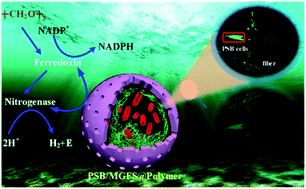Confined encapsulation of living cells in self-assembled fiber macrospheres with micro/nanoporous polymer shells for the transformation of contaminants to green energy†
Abstract
The encapsulation of living cells in the transformation of contaminants into green energy has great potential for solving energy and environmental pollution problems. However, some unresolved challenges related to the maintenance of the capsules' mechanical stability, biomass harvesting without leaking and necessary high activities hinder its practicability. Here, we develop a novel “interior division-external capsulation” dual-immobilization method to anchor photosynthetic bacteria into self-assembled fiber macrospheres and coating with polymer layers by phase inversion. The functional sites (C–N, C–OH and N–H) of the modified macrospheres cause more cells to adhere in the cage and its large void volume provides sufficient space for cell harvesting. Micro/nanoporous polymer shells can not only facilitate the rapid diffusion of substrates into the cavity, but also effectively reduce cell leakage. This strategy provides a facile method to significantly enhance the chemical/physical stability of the host and quickly achieve much higher activity of the encapsulated cells in the degradation of organics and H2 production as compared to free cells. Importantly, the core–shell confined encapsulation concept enables the cells to have considerable salt tolerance as high as 80 g L−1 and wide pH stability. The long-term reusability of the self-assembled macrospheres provides extensive application prospects for cell encapsulation as a clean and sustainable alternative in broader fields.



 Please wait while we load your content...
Please wait while we load your content...